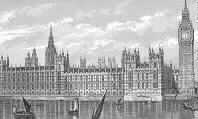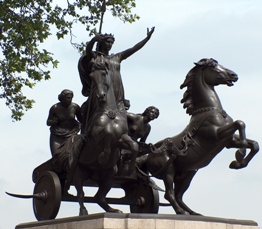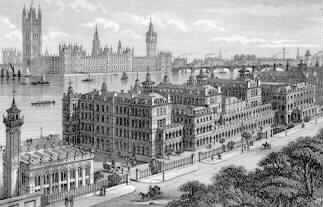 Houses of Parliament from next to Westminster Bridge.
Houses of Parliament from next to Westminster Bridge.
 Houses of Parliament from next to Westminster Bridge.
Houses of Parliament from next to Westminster Bridge.
Westminster Bridge is worth noting on these pages because of the important statue at each end, and views of Victorian interest.
The bridge replaces an earlier 18th century structure, which engravings show to have had no less than 15 arches - the most of any bridge in London, I think, - semicircular, increasing in height and width towards the centre, and with turretlike piers giving the whole a fortified look.
The current bridge, though, is Victorian, dating from 1854-62, by Thomas Page, with Charles Barry as architectural consultant. If you click on the small picture above, the full size version shows the bridge on the very right of the picture. Downstream, the right hand side is dominated by the London Eye, and closer to us and to the preoccupation of these pages, the Edwardian former County Hall (architect Ralph Knott, 1912), with some sculpture which is not appreciable from here.
To the left, just off Parliament Square, Portcullis House is one of the better modern constructions, the whole and the chimneys echoing in scale and height New Scotland Yard next door, with its distinctive white banding on a red brick background, and which is by Richard Norman Shaw. A little way on, on the shore side of the road, a golden eagle raised on high (WW1 monument to American Airmen). Further, behind more trees, the excellent skyline of Whitehall Court and National Liberal Club, by Archer and Green, and Waterhouse respectively (1884). They are noted on the Victoria Embankment page.
The next bridge downriver is the Hungerford Rail Bridge, leading out of Charing Cross railway station, with on each side a modern suspension bridge for pedestrians by Lifshutz Davidson, (2002) in the best possible taste. The river then curves round to the right, so that behind that bridge can be seen on what is now becoming the north rather than west bank of the Thames, the long low white bulk of Somerset House (William Chambers, late 18th Century).
The upriver view gives an oblique view of the Houses of Parliament, and a slight view of St Thomas's Hospital on the other side - see below for better view from the Albert Embankment. Further off, the next bridge upstream is Lambeth Bridge.
We have a good statue at each end of Westminster bridge. On the western side is Boadicea, by Thomas Thornycroft, the father of the better known and more prolific Hamo Thornycroft. An excellent thing - see this page for details - and probably the sculptor's best work, she is seen in her two horse chariot with its scythe-bearing wheels, used in battle with the Romans. This is Boadicea as a noble warrior, not personalised but semi-deified, accompanied by two crouching female shield maidens.
 Thomas Thornycroft's Boadicea.
Thomas Thornycroft's Boadicea.
At the other end of the bridge is the very large Coade Stone Lion (1837), facing away from us. This originally advertised the Lambeth brewery and is the work of the Coade Stone manufactury, which stood where County Hall now sits, and I think the lion faced the other way, towards the river. Big, solid, much less subtle than many works in the material, but interesting in demonstrating the scale that Coade Stone could be used on, and the imperishable nature of the material, given the lion's exposed windy position.
 St Thomas's Hospital, Parliament, Westminster Bridge to right.
St Thomas's Hospital, Parliament, Westminster Bridge to right.
From that side of the river, on the Albert Embankment, the bridge itself can be seen. It has seven arches, larger in the centre than at the ends, solid rather than fancy ironwork, and unadorned stone piers with short branching triple-lamps at the top to light the road across the bridge. Walking upstream gives the spectacular view of the Houses of Parliament. The river frontage of the building itself is symmetrical, and further back, the Victoria tower at the southern (upstream) end is balanced by the slighter Big Ben at the other together with the smaller towers and steeples nearby, to give a pleasing asymmetry. The central complicated tall spire rises almost as high as the towers at each end - this and the smaller protuberances, an essential part of the Gothicness of the whole, are in fact to cover heating and ventilation shafts. Would that modern buildings had such ornaments. The tops of the white towers of Westminster Abbey are visible behind. The architects, of course, were Barry for the structure and Pugin for the decorative aspects. Building work commenced in 1839, the building becoming basically useable in the late 1840s and early 1850s, Big Ben going up in 1858, and Victorian Tower completed in 1860.
A pleasant walk upriver from here takes one past St Thomas's Hospital, not particularly noticeable from the bridge, due to the trees, and the nearer obscuring modern block. There are three surviving Italianate pavilions with a low, pillared screen between, and a church with excellent Italianate tower. In the picture, the Hospital fills the lower part of the view, and the church is bottom left. The architect was Henry Currey, and the date 1868-71.
The pedestrian can stroll further, past Lambeth Palace to Lambeth bridge and beyond to Vauxhall Bridge, or across it to Tate Britain. The other way is a walk to Tate Modern. On the west side, a couple of minutes brings one to Parliament Square, or one can stick to the riverside and end up going through Victoria Embankment Gardens.
West side, Parliament Square // or go along the Victoria Embankment // or along Whitehall
Visits to this page from 23 Nov 2011: 10,766